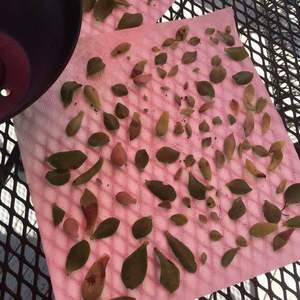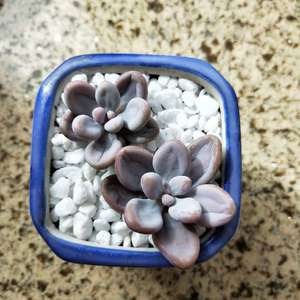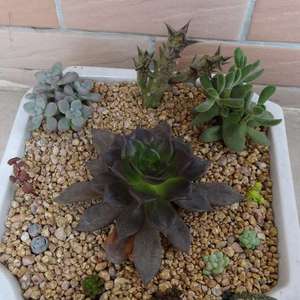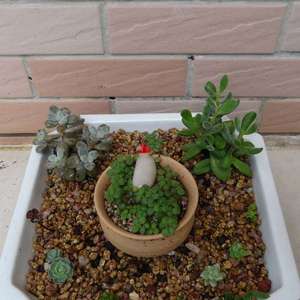文章
Miss Chen
2018年06月17日

Description: This perennial plant is 1-2½' tall, branching occasionally to abundantly. The stems are light green, terete, and appressed-pubescent. The opposite leaves are up to 3" long and 2" across; they have short slender petioles. The leaf blades are oval-cordate, oval, or ovate in shape, while their margins are dentate or dentate-crenate. The upper blade surface is light green and glabrous with a conspicuous network of veins. The upper stems terminate in flat-topped clusters of flowerheads. Each cluster of flowerheads spans about 1-3" across. Each flowerhead has about 40-50 disk florets that are pink, lavender, or blue. Each floret has a tiny tubular corolla with 5 spreading lobes and a strongly exerted style that is divided into two filiform parts. Around the base of each flowerhead, there are several floral bracts (phyllaries) that are arranged in 1-2 series; they are light green and linear in shape. The branches underneath each flowerhead cluster are light green and terete.
The blooming period occurs from mid-summer to early autumn, lasting about 1-2 months. There is no noticeable floral scent. Afterwards, the florets are replaced by achenes with small tufts of hair; they are distributed by the wind. The root system is highly rhizomatous; this plant readily forms colonies.
Cultivation: The preference is full sun to light shade, moist conditions, and soil containing loam or silt. There should be sufficient organic material in the soil to retain moisture. This plant can spread aggressively in moist open ground, otherwise it presents few problems. Drought tolerance is poor. Propagation is by seed or division of the rhizomes.

Range & Distribution: The native Mistflower occurs in the southern half of Illinois and the Chicago area (see Distribution Map). It is fairly common in southern Illinois, but uncommon or absent elsewhere. This plant was introduced into the Chicago area. Some local populations in the wild are probably the result of seeds or plants that have escaped cultivation. Habitats include river-bottom prairies, moist open woodlands, gravelly seeps, borders of lakes and rivers, moist meadows in wooded areas, bases of bluffs, and ditches. This plant usually occurs in poorly drained areas and near sources of water.
Faunal Associations: The flowers attract long-tongued bees, butterflies, and skippers. Other occasional visitors include short-tongued bees, various flies, moths, and beetles. These insects seek nectar primarily, although the bees often collect pollen. Insects that feed on Eupatorium spp. (Bonesets) may also feed on Mistflower. Insect feeders of this group of plants include the caterpillars of such moths as Haploa clymene (Clymene Moth; eats foliage), Phragmatobia lineata (Lined Ruby Tiger Moth; eats foliage), Carmenta bassiformis (Eupatorium Borer Moth; bores into roots), and Schinia trifascia (Three-Lined Flower Moth; eats florets & developing seeds). Mammalian herbivores rarely consume Mistflower because of its bitter foliage.

Photographic Location: The photograph was taken along a drainage canal at Kaufman Lake Park in Champaign, Illinois.
Comments: Mistflower has attractive delicate flowers that are colored in pastel shades of pink, lavender, or blue. For this reason, it is often grown in flower gardens. This plant is closely related to the white-flowered Bonesets (Eupatorium spp.), and sometimes it is still referred to as Eupatorium coelestinum. Mistflower can be distinguished from the Bonesets primarily by its colorful flowers, relatively short stature, and broad opposite leaves that are heavily veined. While species of Joe-Pye Weed (Eupatoriadelphus spp.) have similar colorful flowers, they are taller plants with whorled leaves. All of these species are similar in that their flowerheads consist entirely of disk florets.
The blooming period occurs from mid-summer to early autumn, lasting about 1-2 months. There is no noticeable floral scent. Afterwards, the florets are replaced by achenes with small tufts of hair; they are distributed by the wind. The root system is highly rhizomatous; this plant readily forms colonies.
Cultivation: The preference is full sun to light shade, moist conditions, and soil containing loam or silt. There should be sufficient organic material in the soil to retain moisture. This plant can spread aggressively in moist open ground, otherwise it presents few problems. Drought tolerance is poor. Propagation is by seed or division of the rhizomes.

Range & Distribution: The native Mistflower occurs in the southern half of Illinois and the Chicago area (see Distribution Map). It is fairly common in southern Illinois, but uncommon or absent elsewhere. This plant was introduced into the Chicago area. Some local populations in the wild are probably the result of seeds or plants that have escaped cultivation. Habitats include river-bottom prairies, moist open woodlands, gravelly seeps, borders of lakes and rivers, moist meadows in wooded areas, bases of bluffs, and ditches. This plant usually occurs in poorly drained areas and near sources of water.
Faunal Associations: The flowers attract long-tongued bees, butterflies, and skippers. Other occasional visitors include short-tongued bees, various flies, moths, and beetles. These insects seek nectar primarily, although the bees often collect pollen. Insects that feed on Eupatorium spp. (Bonesets) may also feed on Mistflower. Insect feeders of this group of plants include the caterpillars of such moths as Haploa clymene (Clymene Moth; eats foliage), Phragmatobia lineata (Lined Ruby Tiger Moth; eats foliage), Carmenta bassiformis (Eupatorium Borer Moth; bores into roots), and Schinia trifascia (Three-Lined Flower Moth; eats florets & developing seeds). Mammalian herbivores rarely consume Mistflower because of its bitter foliage.

Photographic Location: The photograph was taken along a drainage canal at Kaufman Lake Park in Champaign, Illinois.
Comments: Mistflower has attractive delicate flowers that are colored in pastel shades of pink, lavender, or blue. For this reason, it is often grown in flower gardens. This plant is closely related to the white-flowered Bonesets (Eupatorium spp.), and sometimes it is still referred to as Eupatorium coelestinum. Mistflower can be distinguished from the Bonesets primarily by its colorful flowers, relatively short stature, and broad opposite leaves that are heavily veined. While species of Joe-Pye Weed (Eupatoriadelphus spp.) have similar colorful flowers, they are taller plants with whorled leaves. All of these species are similar in that their flowerheads consist entirely of disk florets.
0
0
文章
Miss Chen
2018年06月16日

Description: This perennial wildflower is 1½–6' tall, branching occasionally along the upper half of its length. The rather stout stems are light green to reddish purple (often the latter), terete to slightly grooved, and evenly covered with stiff spreading hairs. The alternate leaves are up to 6" long and 1¾" across, becoming gradually smaller along the upper half of each plant; they are narrowly lanceolate to lanceolate with poorly defined remote teeth along their margins. The leaves are yellowish green, medium green, or purple (sometimes the latter color during the fall); they are usually glabrous, except for some hairs along the central veins of their lower sides. Most leaves clasp the stems, although some of the smaller upper leaves are sessile.
The central stem terminates in a panicle of flowerheads; some lateral stems may produce smaller panicles of flowerheads. The branches of each panicle are ascending and usually hairy. Along these branches, there are linear-lanceolate leafy bracts up to 1" long. The outer branches terminate in flowerheads about ¾–1¼" across, consisting of 30-50 ray florets and a similar number of central disk florets. The petal-like rays are usually lavender, pale blue-violet, or purple (less often white); they are widely spreading and very slender. The tubular disk florets are 5-lobed; they are initially yellow, but later become dull red. At the base of each flowerhead, there are several overlapping bracts that are linear in shape, green, and hairless; they are rather loosely assembled around the base of the flowerhead and slightly spreading. The blooming period occurs from late summer into the fall and lasts about 2 months. Both disk and ray florets are fertile. The florets are replaced by bullet-shaped achenes about 1.5 mm. long that have small tufts of white hair; they are distributed by the wind. The root system is fibrous and short-rhizomatous, sometimes forming a small caudex on older plants.
Cultivation: The preference is full or partial sun and wet to moist conditions. The soil should contain some organic material to retain moisture and it should be reasonably fertile. Sometimes, the leaves become diseased and rather battered in appearance by the end of the year; the lower leaves may turn brown and fall off in response to droughty conditions. The size of individual plants can be highly variable.
Range & Habitat: The native Swamp Aster is occasional in the northern half of Illinois, while in the southern half of the state it is uncommon or absent. Habitats include soggy thickets along streams, open swamps, fens and calcareous seeps, sedge meadows, and other wetlands. Swamp Aster is often found in higher quality wetlands where the native flora is still intact. It is primarily a boreal species that is found around the Great Lakes and other cool areas.
Faunal Associations: The nectar and pollen of the flowerheads attract a wide variety of insects, including honeybees, bumblebees, other miscellaneous bees, various wasps, bee flies and other miscellaneous flies, and various butterflies, skippers, and moths. The oligolectic bees, Andrena asteris and Andrena hirticincta, suck nectar and collect pollen from the flowerheads of Swamp Aster. Other insects feed on the foliage, suck plant juices, bore through the stalks and roots, or gnaw on the flowers and developing seeds of Symphyotrichum spp. (asters). These species include Microrhopala xerene and other leaf beetles, several aphids (mostly Uroleucon spp.), the stinkbug Trichopepla semivittata, the leafhopper Macrosteles quadrilineatus, the plant bug Plagiognathus cuneatus, Poecilocapsus lineatus (Four-Lined Plant Bug), Lygus lineolaris (Tarnished Plant Bug), and the larvae of Calycomyza humeralis (Aster Leafminer Fly). In addition to these insects, a large number of moth caterpillars feed on asters (see the Moth Table for a listing of these species), as do the caterpillars of the butterflies Chlosyne nycteis (Silvery Checkerspot) and Phyciodes tharos (Pearl Crescent). Among vertebrate animals, the Wild Turkey eats the seeds and leaves occasionally, while the White-Tailed Deer and Cottontail Rabbit browse on the foliage.
Photographic Location: A low area along a pond at Weaver Park in Urbana, Illinois.

Comments: Except for Symphyotrichum novae-angliae (New England Aster), Swamp Aster has larger flowerheads than other Symphyotrichum spp. (asters) in Illinois and its flowerheads usually have more rays (about 30-50). It is a pretty hefty plant that is about as tall as New England Aster. This latter species has glandular hairs along its stems and its leaves are less shiny than those of Swamp Aster. Swamp Aster is divided into two varieties or subspecies: the typical variety/subspecies has evenly hairy purple stems, while variety/subspecies firmus (or lucidulous) has light green stems that are either hairless or the hairs are arranged in lines; sometimes the color of the stems is not reliable in making this distinction. The rhizomes of the typical variety/subspecies are supposed to be short, while the rhizomes of variety/subspecies firmus (or lucidulous) are supposed to be long. Some authors (e.g., Mohlenbrock, 2014), divide Swamp Aster into two separate species: Symphyotrichum puniceum and Symphyotrichum firmum. They have a similar distribution and are about equally common in Illinois. The preceding descriptive information and photos apply to Symphyotrichum puniceum puniceum. A scientific synonym of Swamp Aster is Aster puniceus.
The central stem terminates in a panicle of flowerheads; some lateral stems may produce smaller panicles of flowerheads. The branches of each panicle are ascending and usually hairy. Along these branches, there are linear-lanceolate leafy bracts up to 1" long. The outer branches terminate in flowerheads about ¾–1¼" across, consisting of 30-50 ray florets and a similar number of central disk florets. The petal-like rays are usually lavender, pale blue-violet, or purple (less often white); they are widely spreading and very slender. The tubular disk florets are 5-lobed; they are initially yellow, but later become dull red. At the base of each flowerhead, there are several overlapping bracts that are linear in shape, green, and hairless; they are rather loosely assembled around the base of the flowerhead and slightly spreading. The blooming period occurs from late summer into the fall and lasts about 2 months. Both disk and ray florets are fertile. The florets are replaced by bullet-shaped achenes about 1.5 mm. long that have small tufts of white hair; they are distributed by the wind. The root system is fibrous and short-rhizomatous, sometimes forming a small caudex on older plants.
Cultivation: The preference is full or partial sun and wet to moist conditions. The soil should contain some organic material to retain moisture and it should be reasonably fertile. Sometimes, the leaves become diseased and rather battered in appearance by the end of the year; the lower leaves may turn brown and fall off in response to droughty conditions. The size of individual plants can be highly variable.
Range & Habitat: The native Swamp Aster is occasional in the northern half of Illinois, while in the southern half of the state it is uncommon or absent. Habitats include soggy thickets along streams, open swamps, fens and calcareous seeps, sedge meadows, and other wetlands. Swamp Aster is often found in higher quality wetlands where the native flora is still intact. It is primarily a boreal species that is found around the Great Lakes and other cool areas.
Faunal Associations: The nectar and pollen of the flowerheads attract a wide variety of insects, including honeybees, bumblebees, other miscellaneous bees, various wasps, bee flies and other miscellaneous flies, and various butterflies, skippers, and moths. The oligolectic bees, Andrena asteris and Andrena hirticincta, suck nectar and collect pollen from the flowerheads of Swamp Aster. Other insects feed on the foliage, suck plant juices, bore through the stalks and roots, or gnaw on the flowers and developing seeds of Symphyotrichum spp. (asters). These species include Microrhopala xerene and other leaf beetles, several aphids (mostly Uroleucon spp.), the stinkbug Trichopepla semivittata, the leafhopper Macrosteles quadrilineatus, the plant bug Plagiognathus cuneatus, Poecilocapsus lineatus (Four-Lined Plant Bug), Lygus lineolaris (Tarnished Plant Bug), and the larvae of Calycomyza humeralis (Aster Leafminer Fly). In addition to these insects, a large number of moth caterpillars feed on asters (see the Moth Table for a listing of these species), as do the caterpillars of the butterflies Chlosyne nycteis (Silvery Checkerspot) and Phyciodes tharos (Pearl Crescent). Among vertebrate animals, the Wild Turkey eats the seeds and leaves occasionally, while the White-Tailed Deer and Cottontail Rabbit browse on the foliage.
Photographic Location: A low area along a pond at Weaver Park in Urbana, Illinois.

Comments: Except for Symphyotrichum novae-angliae (New England Aster), Swamp Aster has larger flowerheads than other Symphyotrichum spp. (asters) in Illinois and its flowerheads usually have more rays (about 30-50). It is a pretty hefty plant that is about as tall as New England Aster. This latter species has glandular hairs along its stems and its leaves are less shiny than those of Swamp Aster. Swamp Aster is divided into two varieties or subspecies: the typical variety/subspecies has evenly hairy purple stems, while variety/subspecies firmus (or lucidulous) has light green stems that are either hairless or the hairs are arranged in lines; sometimes the color of the stems is not reliable in making this distinction. The rhizomes of the typical variety/subspecies are supposed to be short, while the rhizomes of variety/subspecies firmus (or lucidulous) are supposed to be long. Some authors (e.g., Mohlenbrock, 2014), divide Swamp Aster into two separate species: Symphyotrichum puniceum and Symphyotrichum firmum. They have a similar distribution and are about equally common in Illinois. The preceding descriptive information and photos apply to Symphyotrichum puniceum puniceum. A scientific synonym of Swamp Aster is Aster puniceus.
0
0
文章
Miss Chen
2018年06月16日

Description: This herbaceous perennial plant forms a small tuft of ascending to arching basal leaves about 4-12" (10-30 cm.) long. Individual basal leaves are about 1 mm. across, medium green, terete, and hairless (or nearly so). One or two erect floral stalks about 8-16" (20-40 cm.) long develop from the tuft of leaves; these stalks are about 1.5 mm. across, reddish brown, terete, and hairless. The foliage is reportedly aromatic when crushed. Each stalk has a narrow raceme of flowers about 3-10" (7.5-25 cm.) long; these flowers alternate along the stalk and they are sparsely distributed. Each flower is about 2 mm. across, consisting of 3 purplish green petals, 3 purplish green sepals, 3 fertile green pistils that are joined together, and 6 inconspicuous stamens. The outer sepals are orbicular-ovate in shape, while the inner petals have a flattened-pyriform shape. The stigmas of the pistils are white and feathery (plumose).
The slender pedicels of the flowers are 2-10 mm. long, ascending to erect, reddish brown, and hairless. The blooming period occurs during the summer and early autumn, lasting about 1-2 months for a large colony of plants. The flowers are cross-pollinated by the wind. Afterwards, the pistils develop into 3-celled fruits (schizocarps) about 7-9 mm. long and 1 mm. across. These fruits are narrowly oblongoid-oblanceoloid in shape and 3-angled; they are initially green, but later become brown. At maturity, these fruits divide longitudinally into 3 narrow sections, beginning at the bottom. The central axis of each fruit is 3-winged; there are 3 seeds per fruit. The seeds are similar in appearance to their fruits, but a little shorter and more slender. The root system consists of a whitish crown with fibrous roots.

Cultivation: The preference is full sun, wet conditions, and a barren calcareous soil containing an abundance of sand or gravel. This plant is intolerant of competition from other ground vegetation. It is quite cold-hardy.
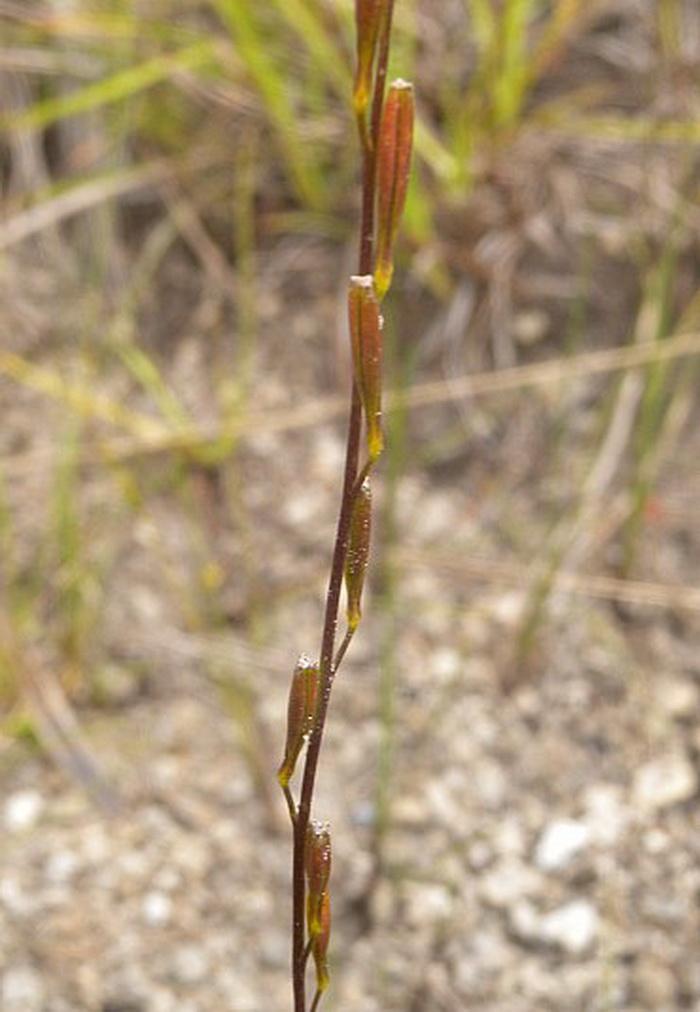
Range & Habitat: The native Slender Arrowgrass (Triglochin palustris) is rare in Illinois, where it is state-listed as 'endangered.' It is found in the NE section of the state and 2 counties toward the center of the state (see Distribution Map). Illinois lies along the southern range-limit of this species. In the United States, Slender Arrowgrass occurs in the New England region, Great Lakes area, Northern Plains, and scattered areas of the western states. It also occurs in Canada, Eurasia, and New Zealand. In Illinois, habitats consist primarily of fens, calcareous gravelly seeps, marl flats, and calcareous sandy pannes near Lake Michigan. This very conservative plant is restricted to high quality natural areas within the state.

Faunal Associations: Floral-faunal relationships of this plant in Illinois are not known. Further to the north in Canada and Alaska, the foliage and especially the whitish crowns are a preferred source of food for the adults and goslings of several species of geese, including Branta canadensis (Canada Goose), Branta bernicula nigricans (Black Brant Goose), and Chen caerulescens (Lesser Snow Goose). The foliage and crowns of Slender Arrowgrass (Triglochin palustris) are reportedly high in protein and low in fiber (Mulder et al., 1996; Prevett et al., 1985).

The foliage also contains hydrocyanic compounds that can be toxic to sheep and cattle if it is consumed in sufficient quantity. There is some evidence in Europe that the seeds of this plant can cling to the fur of deer and cattle. Thus, these animals can spread the seeds to new areas (Mouissie et al., 2005).
Photographic Location: A gravelly seep in McHenry County, Illinois.
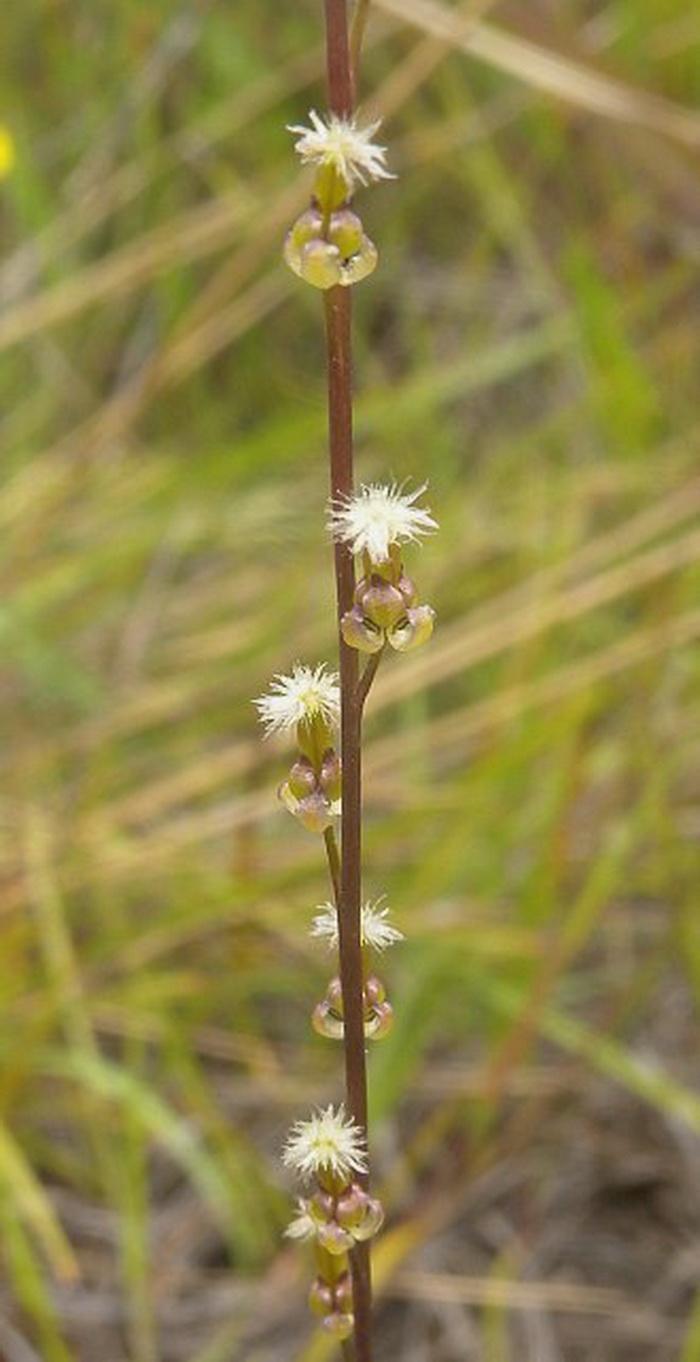
Comments: This plant is not very showy and it is easily overlooked. The only other species of this genus that occurs in Illinois, Sea Arrowgrass (Triglochin maritima), is also very rare within the state and it occurs in similar areas. Sea Arrowgrass is a little larger and stouter than Slender Arrowgrass (Triglochin palustris) overall. Its fruits (schizocarps) have a wider ovoid shape and they divide into 6 sections (6 seeds per fruit), rather than 3 sections. Unlike Slender Arrowgrass, the central axis of its fruit is not winged. The wind-pollinated flowers of these plants are rather odd-looking because their feathery stigmas resemble tufts of hair that are typically found on seeds. An alternative spelling of the scientific name for Slender Arrowgrass is Triglochin palustre, and another common name of this plant is Marsh Arrowgrass.
The slender pedicels of the flowers are 2-10 mm. long, ascending to erect, reddish brown, and hairless. The blooming period occurs during the summer and early autumn, lasting about 1-2 months for a large colony of plants. The flowers are cross-pollinated by the wind. Afterwards, the pistils develop into 3-celled fruits (schizocarps) about 7-9 mm. long and 1 mm. across. These fruits are narrowly oblongoid-oblanceoloid in shape and 3-angled; they are initially green, but later become brown. At maturity, these fruits divide longitudinally into 3 narrow sections, beginning at the bottom. The central axis of each fruit is 3-winged; there are 3 seeds per fruit. The seeds are similar in appearance to their fruits, but a little shorter and more slender. The root system consists of a whitish crown with fibrous roots.

Cultivation: The preference is full sun, wet conditions, and a barren calcareous soil containing an abundance of sand or gravel. This plant is intolerant of competition from other ground vegetation. It is quite cold-hardy.

Range & Habitat: The native Slender Arrowgrass (Triglochin palustris) is rare in Illinois, where it is state-listed as 'endangered.' It is found in the NE section of the state and 2 counties toward the center of the state (see Distribution Map). Illinois lies along the southern range-limit of this species. In the United States, Slender Arrowgrass occurs in the New England region, Great Lakes area, Northern Plains, and scattered areas of the western states. It also occurs in Canada, Eurasia, and New Zealand. In Illinois, habitats consist primarily of fens, calcareous gravelly seeps, marl flats, and calcareous sandy pannes near Lake Michigan. This very conservative plant is restricted to high quality natural areas within the state.

Faunal Associations: Floral-faunal relationships of this plant in Illinois are not known. Further to the north in Canada and Alaska, the foliage and especially the whitish crowns are a preferred source of food for the adults and goslings of several species of geese, including Branta canadensis (Canada Goose), Branta bernicula nigricans (Black Brant Goose), and Chen caerulescens (Lesser Snow Goose). The foliage and crowns of Slender Arrowgrass (Triglochin palustris) are reportedly high in protein and low in fiber (Mulder et al., 1996; Prevett et al., 1985).

The foliage also contains hydrocyanic compounds that can be toxic to sheep and cattle if it is consumed in sufficient quantity. There is some evidence in Europe that the seeds of this plant can cling to the fur of deer and cattle. Thus, these animals can spread the seeds to new areas (Mouissie et al., 2005).
Photographic Location: A gravelly seep in McHenry County, Illinois.

Comments: This plant is not very showy and it is easily overlooked. The only other species of this genus that occurs in Illinois, Sea Arrowgrass (Triglochin maritima), is also very rare within the state and it occurs in similar areas. Sea Arrowgrass is a little larger and stouter than Slender Arrowgrass (Triglochin palustris) overall. Its fruits (schizocarps) have a wider ovoid shape and they divide into 6 sections (6 seeds per fruit), rather than 3 sections. Unlike Slender Arrowgrass, the central axis of its fruit is not winged. The wind-pollinated flowers of these plants are rather odd-looking because their feathery stigmas resemble tufts of hair that are typically found on seeds. An alternative spelling of the scientific name for Slender Arrowgrass is Triglochin palustre, and another common name of this plant is Marsh Arrowgrass.
0
0
文章
Miss Chen
2018年06月15日

Description: This perennial plant is 3-5' tall, branching sparingly to occasionally. It has greenish stems that are angular and winged. The alternate leaves are up to 5" long and 1½" across; they are lanceolate-oblong to elliptic-oblong in shape and slightly serrated along their margins. The leaves are either sessile or their bases clasp the stems. Upper stems terminate in flowerheads spanning about 1½-2" across; they are usually produced in abundance. Each flowerhead has a slightly flattened to globoid head of yellow disk florets that is surrounded by yellow ray florets. The petaloid rays of the latter florets are narrowly triangular in shape (broader at their tips than at their bases). The tips of these unusual rays are doubly notched, creating an interesting effect. The tubular corollas of the tiny disk florets are less than 1/8" across. The blooming period occurs during the autumn for 1-2 months. Afterwards, the florets are replaced by achenes that lack tufts of hair; they are distributed in part by water. The root system is shallow and fibrous.
Cultivation: The preference is full to partial sun, wet to moist conditions, and soil containing loam or silt that is relatively high in organic material. Common Sneezeweed can appear sloppy and unkempt, particularly if it is allowed to dry out.
Range & Habitat: The native Common Sneezeweed occurs throughout Illinois, where it is quite common in the central and northern sections of the state (see Distribution Map). In southern Illinois, this plant is less common or absent. Habitats include moist black soil prairies, moist meadows in wooded areas, moist meadows along rivers, moist open woodlands, soggy thickets, fens, marshes, poorly drained pastures and abandoned fields, low areas along streams and ponds, and ditches. It is not uncommon to find this plant growing within a few feet of water in both disturbed areas and higher quality habitats. Recovery from fire is poor.

Faunal Associations: Probably the most common visitors to the flowers are long-tongued bees, including honeybees, bumblebees, long-horned bees (Melissodes spp.), cuckoo bees (Coelioxys spp., Triepeolus spp.), and leaf-cutting bees (Megachile spp.). Other visitors include Halictid bees, Sphecid wasps, Vespid wasps, Syrphid flies, butterflies, and beetles. Most of these insects suck nectar, although some bees also collect pollen and some beetles feed on the pollen. The aphids Aphis vernoniae and Uroleucon tardae suck plant juices from Common Sneezeweed, while the caterpillars of Papaipema rigida (Rigid Sunflower Borer Moth) bore through its stems and feed on the pith. Mammalian herbivores usually don't feed on this plant because its foliage is toxic and bitter. There have been reports of severe poisoning for livestock that have consumed this plant, producing such symptoms as congestion of the kidneys and liver, formation of necrotic areas in the lungs, and irritation of the digestive tract. Not surprisingly, Common Sneezeweed is considered an 'increaser' in grazed meadows.

Photographic Location: The photographs were taken near a drainage ditch at Judge Webber Park in Urbana, Illinois, and in a wetland area of Weaver Park of the same city.
Comments: Notwithstanding its common name, this plant doesn't cause sneezing or hay fever during the autumn – its pollen is distributed by insects, rather than the wind. Common Sneezeweed blooms quite late in the year, providing some fall color when other plants have finished blooming. A similar species, Helenium flexuosum (Purple-Headed Sneezeweed), differs from Common Sneezeweed by having disk florets that are purple, rather than yellow, and its foliage is more soft-hairy. This latter species is native to southern Illinois.
Cultivation: The preference is full to partial sun, wet to moist conditions, and soil containing loam or silt that is relatively high in organic material. Common Sneezeweed can appear sloppy and unkempt, particularly if it is allowed to dry out.
Range & Habitat: The native Common Sneezeweed occurs throughout Illinois, where it is quite common in the central and northern sections of the state (see Distribution Map). In southern Illinois, this plant is less common or absent. Habitats include moist black soil prairies, moist meadows in wooded areas, moist meadows along rivers, moist open woodlands, soggy thickets, fens, marshes, poorly drained pastures and abandoned fields, low areas along streams and ponds, and ditches. It is not uncommon to find this plant growing within a few feet of water in both disturbed areas and higher quality habitats. Recovery from fire is poor.

Faunal Associations: Probably the most common visitors to the flowers are long-tongued bees, including honeybees, bumblebees, long-horned bees (Melissodes spp.), cuckoo bees (Coelioxys spp., Triepeolus spp.), and leaf-cutting bees (Megachile spp.). Other visitors include Halictid bees, Sphecid wasps, Vespid wasps, Syrphid flies, butterflies, and beetles. Most of these insects suck nectar, although some bees also collect pollen and some beetles feed on the pollen. The aphids Aphis vernoniae and Uroleucon tardae suck plant juices from Common Sneezeweed, while the caterpillars of Papaipema rigida (Rigid Sunflower Borer Moth) bore through its stems and feed on the pith. Mammalian herbivores usually don't feed on this plant because its foliage is toxic and bitter. There have been reports of severe poisoning for livestock that have consumed this plant, producing such symptoms as congestion of the kidneys and liver, formation of necrotic areas in the lungs, and irritation of the digestive tract. Not surprisingly, Common Sneezeweed is considered an 'increaser' in grazed meadows.

Photographic Location: The photographs were taken near a drainage ditch at Judge Webber Park in Urbana, Illinois, and in a wetland area of Weaver Park of the same city.
Comments: Notwithstanding its common name, this plant doesn't cause sneezing or hay fever during the autumn – its pollen is distributed by insects, rather than the wind. Common Sneezeweed blooms quite late in the year, providing some fall color when other plants have finished blooming. A similar species, Helenium flexuosum (Purple-Headed Sneezeweed), differs from Common Sneezeweed by having disk florets that are purple, rather than yellow, and its foliage is more soft-hairy. This latter species is native to southern Illinois.
0
0
文章
Miss Chen
2018年06月14日

Description: This perennial plant is 1½–3½' tall, branching occasionally. The stems are light green or light reddish green, glabrous, and glaucous. The compound leaves are up to 1' long and 8" across (excluding their petioles), becoming smaller as they ascend the stems; they are alternate, green, and glabrous. The lower leaves are double-pinnate, while the upper leaves are often simple-pinnate. The petioles of the lower leaves are long, while those of the upper leaves are much shorter or absent. The leaflets are up to 3" long and 1/3" (8 mm.) across; they are linear to lanceolate-linear, dentate, and sometimes cleft into narrow lobes. The axils of the upper leaves often have sessile clusters of ovoid bulblets. The upper stems terminate in compound umbels of small white flowers.
Each compound umbel spans about 2-4" across and it consists of about 8 umbellets. Each umbellet has about 16 flowers. There are neither bracts nor bractlets at the base of the compound umbel and its umbellets, although a small sessile leaf may occur near the base of the compound umbel. Each flower spans about 1/8" (3 mm.) across or a little less, consisting of 5 white petals, 5 stamens, 2 styles, and an ovary. The blooming period occurs during late summer to early autumn and it lasts about one month. There is no noticeable floral scent. A pair of seeds are contained in each fruit (schizocarp). These fruits are about 1/8" (3 mm.) long; they are somewhat flattened, ovoid-oblongoid in shape, and slightly notched at their apices. The root system consists of a cluster of elongated fleshy roots. The foliage, seeds, and fleshy roots are toxic (especially the latter). This plant reproduces by seeds and aerial bulblets.

Cultivation: The preference is light shade to full sun, wet conditions, and a mucky or mossy soil. This plant requires soil that is saturated with moisture throughout the year.
Range & Habitat: The native Bulblet-Bearing Water Hemlock is an uncommon plant that occurs primarily in the northern half of Illinois, especially in the NE area of the state (see Distribution Map). Habitats include both sandy and non-sandy marshes, swamps, and borders of lakes and ponds. This species is normally found in high quality wetlands.

Faunal Associations: Like other members of the Carrot family, the nectar of the flowers is accessible to insects with short mouthparts, therefore they will attract such visitors as flies, wasps, beetles, and small bees. Some of these insects may collect or feed on the pollen as well. The caterpillars of a butterfly, Papilio polyxenes asterias (Black Swallowtail), feed on the foliage. Other insects that feed on water hemlock species (Cicuta spp.) include stem-boring larvae of a weevil (Apion pensylvanicum), flower- and fruit-eating larvae of an Epermeniid moth (Epermenia cicutaella), flower- and fruit-eating nymphs and adults of Orthops scutellatus (Carrot Plant Bug), Cavariella aegopodii (Carrot-Willow Aphid) and other Cavariella spp., and Hyadaphis foeniculi (Honeysuckle-Fennel Aphid); see Majka et al. (2007), Covell (1984/2005), Wheeler et al. (1983), Blackman & Eastop (2013), and Pepper (1965). The poisonous seeds are not eaten by birds, while the poisonous foliage and roots are usually avoided by mammalian herbivores. Consumption of the fleshy roots and other parts of this plant by either mammalian herbivores or humans can cause convulsions and death.
Photographic Location: A sandy marsh at the Heron Boardwalk in Vermilion County, Illinois.

Comments: Bulblet-Bearing Water Hemlock is highly unusual because it bears clusters of bulblets in the upper leaf axils. With the exception of Ranunculus ficaria (Lesser Celandine), I can think of no other plant in Illinois that has this characteristic. Some Allium spp. (Onions) produce bulblets instead of flowers in their umbels, but their bulblets are not produced from the axils of leaves. Another species that occurs within the state, Cicuta maculata (Water Hemlock) is more common. Water Hemlock is a larger plant than Bulblet-Bearing Water Hemlock and it has broader leaflets (more than 1/3" or 8 mm. across). Water Hemlock blooms during mid-summer before Bulblet-Bearing Water Hemlock begins to bloom. Another white-flowered member of the Carrot family, Sium suave (Water Parsnip), often blooms at the same time as Bulblet-Bearing Water Hemlock and it occurs in the same wetland habitats. Water Parsnip has about 3 lanceolate bracts at the base of its compound umbels and its leaves are always simple-pinnate. Another similar species that blooms late, Oxypolis rigidior (Cowbane), also has leaves that are simple-pinnate. In contrast, the lower leaves of Bulblet-Bearing Water Hemlock are double-pinnate.
Each compound umbel spans about 2-4" across and it consists of about 8 umbellets. Each umbellet has about 16 flowers. There are neither bracts nor bractlets at the base of the compound umbel and its umbellets, although a small sessile leaf may occur near the base of the compound umbel. Each flower spans about 1/8" (3 mm.) across or a little less, consisting of 5 white petals, 5 stamens, 2 styles, and an ovary. The blooming period occurs during late summer to early autumn and it lasts about one month. There is no noticeable floral scent. A pair of seeds are contained in each fruit (schizocarp). These fruits are about 1/8" (3 mm.) long; they are somewhat flattened, ovoid-oblongoid in shape, and slightly notched at their apices. The root system consists of a cluster of elongated fleshy roots. The foliage, seeds, and fleshy roots are toxic (especially the latter). This plant reproduces by seeds and aerial bulblets.

Cultivation: The preference is light shade to full sun, wet conditions, and a mucky or mossy soil. This plant requires soil that is saturated with moisture throughout the year.
Range & Habitat: The native Bulblet-Bearing Water Hemlock is an uncommon plant that occurs primarily in the northern half of Illinois, especially in the NE area of the state (see Distribution Map). Habitats include both sandy and non-sandy marshes, swamps, and borders of lakes and ponds. This species is normally found in high quality wetlands.

Faunal Associations: Like other members of the Carrot family, the nectar of the flowers is accessible to insects with short mouthparts, therefore they will attract such visitors as flies, wasps, beetles, and small bees. Some of these insects may collect or feed on the pollen as well. The caterpillars of a butterfly, Papilio polyxenes asterias (Black Swallowtail), feed on the foliage. Other insects that feed on water hemlock species (Cicuta spp.) include stem-boring larvae of a weevil (Apion pensylvanicum), flower- and fruit-eating larvae of an Epermeniid moth (Epermenia cicutaella), flower- and fruit-eating nymphs and adults of Orthops scutellatus (Carrot Plant Bug), Cavariella aegopodii (Carrot-Willow Aphid) and other Cavariella spp., and Hyadaphis foeniculi (Honeysuckle-Fennel Aphid); see Majka et al. (2007), Covell (1984/2005), Wheeler et al. (1983), Blackman & Eastop (2013), and Pepper (1965). The poisonous seeds are not eaten by birds, while the poisonous foliage and roots are usually avoided by mammalian herbivores. Consumption of the fleshy roots and other parts of this plant by either mammalian herbivores or humans can cause convulsions and death.
Photographic Location: A sandy marsh at the Heron Boardwalk in Vermilion County, Illinois.

Comments: Bulblet-Bearing Water Hemlock is highly unusual because it bears clusters of bulblets in the upper leaf axils. With the exception of Ranunculus ficaria (Lesser Celandine), I can think of no other plant in Illinois that has this characteristic. Some Allium spp. (Onions) produce bulblets instead of flowers in their umbels, but their bulblets are not produced from the axils of leaves. Another species that occurs within the state, Cicuta maculata (Water Hemlock) is more common. Water Hemlock is a larger plant than Bulblet-Bearing Water Hemlock and it has broader leaflets (more than 1/3" or 8 mm. across). Water Hemlock blooms during mid-summer before Bulblet-Bearing Water Hemlock begins to bloom. Another white-flowered member of the Carrot family, Sium suave (Water Parsnip), often blooms at the same time as Bulblet-Bearing Water Hemlock and it occurs in the same wetland habitats. Water Parsnip has about 3 lanceolate bracts at the base of its compound umbels and its leaves are always simple-pinnate. Another similar species that blooms late, Oxypolis rigidior (Cowbane), also has leaves that are simple-pinnate. In contrast, the lower leaves of Bulblet-Bearing Water Hemlock are double-pinnate.
0
0
文章
Miss Chen
2018年06月14日

Description: This herbaceous perennial plant is 1-3' tall and usually unbranched; it will form side branches if the central stem is broken. The central stem is light green, glabrous, and terete (round in cross-section); there are pairs of opposite leaves along its length that have a tendency to droop. The leaf blades are up to 6" long and 2¼" across; they are lanceolate to broadly lanceolate, hairless, and serrated along their margins. The upper surface of each leaf blade is medium to dark green, while its lower surface is pale green. At the base of each leaf blade, there is a short petiole about ¼–½" in length.
The central stem terminates in a short spike of flowers. Each flower is 1–1½" in length; it has a corolla with a flattened tubular shape and a short calyx with 5 blunt teeth. The two-lipped corolla is pink to deep rosy pink; the upper lip has the shape of a broad hood, while the lower lip has 3 outer lobes. The central lobe of the lower lip is often elevated slightly above the 2 lateral lobes when the flower is fully open. Behind the lower lip of the corolla, there is a conspicuous patch of white or pale yellow hairs. The calyx is light green and glabrous; it has teeth that are broadly ovate or oval-ovate. Underneath the calyx of each flower, there are short appressed bracts that resemble the teeth of the calyx. The blooming period occurs from late summer to early fall and lasts about a month. There is no floral scent. Ovoid seed capsules develop after the corollas of the flowers turn brown and fall off. Each seed capsule is about ½" long; it is initially light green and glabrous, but later turns brown and splits open to release the seeds. The root system is rhizomatous and vegetative colonies of plants occasionally form.
Stems & Leaves
Cultivation: The preference is partial or dappled sunlight, consistently moist conditions, and a fertile loamy soil with abundant organic matter. The foliage is rarely disfigured by disease.
Range & Habitat: The native Pink Turtlehead is an uncommon wildflower that is found primarily in southern and western Illinois; elsewhere in the state, it is rare or absent (see Distribution Map). Habitats include wet to moist floodplain forests, swamps, soggy meadows and thickets, and partially shaded seeps and springs. This species usually occurs in high quality habitats. It is sometimes grown in flower gardens.
Faunal Associations: The flowers are cross-pollinated primarily by bumblebees; sometimes the Ruby-Throated Hummingbird also visits the flowers of Chelone spp. (Turtleheads) for their nectar. The bitter foliage is usually avoided by White-Tailed Deer and other mammalian herbivores.

Comments: Pink Turtlehead is the only native Chelone sp. (Turtlehead) in Illinois with pink to deep rosy pink flowers. It is an attractive plant with turtlehead-shaped flowers. The other native Turtlehead within the state is Chelone glabra (White Turtlehead), which has white (or slightly pink) flowers and shorter petioles (less than ¼"). Sometimes Chelone lyonii (Lyon's Turtlehead) is grown in flower gardens, although it has not naturalized within the state. This species is native to the Appalachian mountains in the SE. Lyon's Turtlehead has flowers that are about the same color as those of Pink Turtlehead, but it has wider leaf blades and longer petioles (½–1½" long). Other common names that refer to Chelone obliqua include Rose Turtlehead, Purple Turtlehead, and Red Turtlehead. Plants that are offered for sale as 'Chelone obliqua' by mass-market nurseries may be hybrids of undetermined parentage, rather than the open-pollinated species.
The central stem terminates in a short spike of flowers. Each flower is 1–1½" in length; it has a corolla with a flattened tubular shape and a short calyx with 5 blunt teeth. The two-lipped corolla is pink to deep rosy pink; the upper lip has the shape of a broad hood, while the lower lip has 3 outer lobes. The central lobe of the lower lip is often elevated slightly above the 2 lateral lobes when the flower is fully open. Behind the lower lip of the corolla, there is a conspicuous patch of white or pale yellow hairs. The calyx is light green and glabrous; it has teeth that are broadly ovate or oval-ovate. Underneath the calyx of each flower, there are short appressed bracts that resemble the teeth of the calyx. The blooming period occurs from late summer to early fall and lasts about a month. There is no floral scent. Ovoid seed capsules develop after the corollas of the flowers turn brown and fall off. Each seed capsule is about ½" long; it is initially light green and glabrous, but later turns brown and splits open to release the seeds. The root system is rhizomatous and vegetative colonies of plants occasionally form.
Stems & Leaves
Cultivation: The preference is partial or dappled sunlight, consistently moist conditions, and a fertile loamy soil with abundant organic matter. The foliage is rarely disfigured by disease.
Range & Habitat: The native Pink Turtlehead is an uncommon wildflower that is found primarily in southern and western Illinois; elsewhere in the state, it is rare or absent (see Distribution Map). Habitats include wet to moist floodplain forests, swamps, soggy meadows and thickets, and partially shaded seeps and springs. This species usually occurs in high quality habitats. It is sometimes grown in flower gardens.
Faunal Associations: The flowers are cross-pollinated primarily by bumblebees; sometimes the Ruby-Throated Hummingbird also visits the flowers of Chelone spp. (Turtleheads) for their nectar. The bitter foliage is usually avoided by White-Tailed Deer and other mammalian herbivores.

Comments: Pink Turtlehead is the only native Chelone sp. (Turtlehead) in Illinois with pink to deep rosy pink flowers. It is an attractive plant with turtlehead-shaped flowers. The other native Turtlehead within the state is Chelone glabra (White Turtlehead), which has white (or slightly pink) flowers and shorter petioles (less than ¼"). Sometimes Chelone lyonii (Lyon's Turtlehead) is grown in flower gardens, although it has not naturalized within the state. This species is native to the Appalachian mountains in the SE. Lyon's Turtlehead has flowers that are about the same color as those of Pink Turtlehead, but it has wider leaf blades and longer petioles (½–1½" long). Other common names that refer to Chelone obliqua include Rose Turtlehead, Purple Turtlehead, and Red Turtlehead. Plants that are offered for sale as 'Chelone obliqua' by mass-market nurseries may be hybrids of undetermined parentage, rather than the open-pollinated species.
0
0










